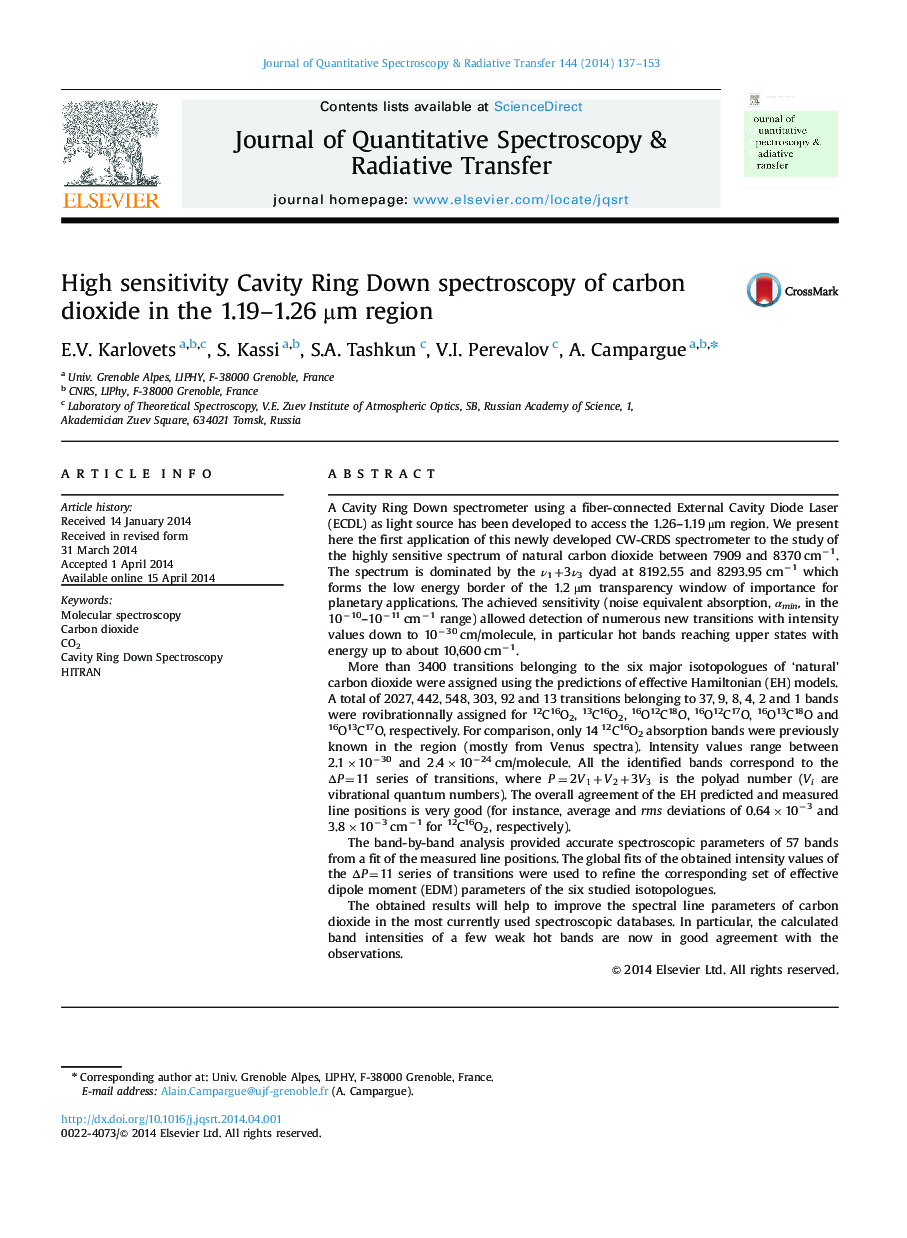| Article ID | Journal | Published Year | Pages | File Type |
|---|---|---|---|---|
| 5428192 | Journal of Quantitative Spectroscopy and Radiative Transfer | 2014 | 17 Pages |
â¢A new CRDS spectrometer using a fibered External Cavity Diode Laser is developed.â¢The CO2 absorption spectrum is recorded with unprecedented sensitivity near 1.2 μm.â¢3425 Transitions are assigned to 61 bands of six isotopologues of carbon dioxide.â¢The spectroscopic parameters of 57 bands are derived from a fit of the line positions.â¢ÎP=11 effective dipole moment parameters are determined for the six isotopologues.
A Cavity Ring Down spectrometer using a fiber-connected External Cavity Diode Laser (ECDL) as light source has been developed to access the 1.26-1.19 μm region. We present here the first application of this newly developed CW-CRDS spectrometer to the study of the highly sensitive spectrum of natural carbon dioxide between 7909 and 8370 cmâ1. The spectrum is dominated by the ν1+3ν3 dyad at 8192.55 and 8293.95 cmâ1 which forms the low energy border of the 1.2 µm transparency window of importance for planetary applications. The achieved sensitivity (noise equivalent absorption, αmin, in the 10â10-10â11 cmâ1 range) allowed detection of numerous new transitions with intensity values down to 10â30 cm/molecule, in particular hot bands reaching upper states with energy up to about 10,600 cmâ1.More than 3400 transitions belonging to the six major isotopologues of 'natural' carbon dioxide were assigned using the predictions of effective Hamiltonian (EH) models. A total of 2027, 442, 548, 303, 92 and 13 transitions belonging to 37, 9, 8, 4, 2 and 1 bands were rovibrationnally assigned for 12C16O2, 13C16O2, 16O12C18O, 16O12C17O, 16O13C18O and 16O13C17O, respectively. For comparison, only 14 12C16O2 absorption bands were previously known in the region (mostly from Venus spectra). Intensity values range between 2.1Ã10â30 and 2.4Ã10â24 cm/molecule. All the identified bands correspond to the ÎP=11 series of transitions, where P=2V1+V2+3V3 is the polyad number (Vi are vibrational quantum numbers). The overall agreement of the EH predicted and measured line positions is very good (for instance, average and rms deviations of 0.64Ã10â3 and 3.8Ã10â3 cmâ1 for 12C16O2, respectively).The band-by-band analysis provided accurate spectroscopic parameters of 57 bands from a fit of the measured line positions. The global fits of the obtained intensity values of the ÎP=11 series of transitions were used to refine the corresponding set of effective dipole moment (EDM) parameters of the six studied isotopologues.The obtained results will help to improve the spectral line parameters of carbon dioxide in the most currently used spectroscopic databases. In particular, the calculated band intensities of a few weak hot bands are now in good agreement with the observations.
